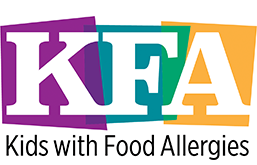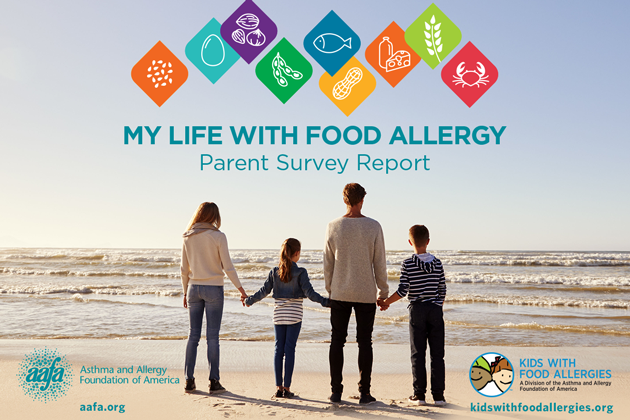Living with Food Allergies

Food Allergy Facts and Figures
Kids with Food Allergies (KFA) is here to help keep your family safe and healthy. KFA is part of the nation’s oldest and largest asthma and allergy charity, the Asthma and Allergy Foundation of America (AAFA).
What Is a Food Allergy?
- A food allergy occurs when the body’s immune system sees a certain food as harmful and reacts by causing specific clinical symptoms. This is an allergic reaction.
- There are 2 types of food allergies:
- Immunoglobulin-E-mediated (IgE-mediated): With this type of food allergy, the body’s immune system makes antibodies called immunoglobulin E (IgE). IgE antibodies react with a certain food and causes symptoms.
- Non-IgE-mediated: Other parts of the body’s immune system react to a certain food. This reaction causes symptoms but does not involve IgE antibodies.
- Two types of food allergy that are classified as non-IgE mediated are:
- Eosinophilic esophagitis (EoE): a chronic (long-term) allergic or immune condition that causes swelling in your esophagus.
- Food protein-induced enterocolitis syndrome (FPIES): an immune reaction in the gastrointestinal (GI) tract, that commonly causes vomiting, diarrhea, and lethargy. Symptoms usually appear about 1 to 4 hours after eating a food trigger.
- Foods that cause allergic reactions are called allergens. People are usually allergic to proteins found in a food allergen.
- Allergic reactions can involve the skin, mouth, throat, eyes, lungs, heart, gut, and brain.
- Severe symptoms can lead to a serious allergic reaction called anaphylaxis [anna-fih-LACK-sis]. This reaction usually involves more than 1 part of the body, can worsen quickly, and can be life-threatening. In some cases, it can lead to death.
- Anaphylaxis must be recognized and treated right away with epinephrine to provide the best chance for improvement and to prevent serious, potentially life-threatening complications.
How Common Are Food Allergies?
- As of 2021, about 20 million people have food allergies in the U.S.1,2
- About 16 million (6.2%) U.S. adults have food allergies.1
- About 4 million (5.8%) U.S. children have food allergies.2
- In 2021, 8.5% of non-Hispanic Black adults had food allergies, compared to 6.2% of non-Hispanic White adults.1
- In 2021, 7.6% of non-Hispanic Black children had food allergies, compared to 5.3% of non-Hispanic White children.2
- Food allergy rates increased among U.S. children from 1988 to 2011, with the greatest increase in Black children.3
- While male and female children have the same rates of food allergy, female adults are more likely to have food allergy than male adults.1,2
- Around 1 in 700 people in the United States have EoE4
- EoE is more common in males than females, and most common in people aged 40-44 years old.4
- FPIES affects about 900,000 people in the United States, including 0.5% of children and 0.2% of adults. 5
What Are the Most Frequent Food Allergens?
- Nine foods cause most food allergy reactions in the United States:6,7,8
- Milk: Affects 1.9% of children and 1.9% of adults
- Egg: Affects 0.9% of children and 0.8% of adults
- Peanut: Affects 2.2% of children and 1.8% of adults
- Tree nut (for example, almonds, walnut, pecans, cashews, pistachios): Affects 1.2% of children and 1.2% of adults
- Fish (for example, bass, flounder, cod): Affects 0.6% of children and 0.9% of adults
- Shellfish (for example, crab, shrimp, scallop, clams): Affects 1.3% of children and 2.9% of adults
- Wheat Affects 0.5% of children and 0.8% of adults
- Soy: Affects 0.5% of children and 0.6% of adults
- Sesame: Affects 0.2% of children and 0.2% of adults
- Milk, wheat, and egg are the most common food triggers of EoE.9
- Milk, soy, rice, and oat are the most common food triggers among children with FPIES. In adults, fish and shellfish are the most common triggers.5
- Sesame is a rising food allergy. It impacts an estimated 1 million people in the United States.10 It was declared a major allergen in the United States in 2021.
What Is Anaphylaxis?
- Anaphylaxis is a severe, potentially life-threatening allergic reaction that comes on quickly and in rare cases can cause death. Not all allergic reactions are anaphylaxis.6
- Symptoms of anaphylaxis can involve more than one part of the body such as the skin, mouth, throat, eyes, lungs, heart, gut, and brain.
- Symptoms of anaphylaxis can include:
- Skin: hives (often very itchy), flushed skin, or rash
- Mouth: swelling of the lips, tongue, and throat; tingling or itchy feeling in the mouth
- Lungs: shortness of breath, trouble breathing, coughing, or wheezing
- Eyes: swelling around the eyes, itchiness
- Brain: feeling a sense of doom
- Heart: dizziness, lightheadedness, loss of consciousness, low blood pressure, shock
- Stomach and gut: cramps, vomiting, diarrhea6
- On average, it is estimated that anaphylaxis results in 45,000-50,000 emergency room visits in the United States each year, with food being the most common trigger.11
- From 2008 to 2016, emergency room visits for anaphylaxis more than doubled.11
- From 1999-2010, there were about 165 deaths from food-related anaphylaxis.12
How Are Food Allergies Managed and Treated?
- Although treatments are available, there is currently no cure for food allergies.6
- Strictly avoiding a food allergen and not eating it is the primary way to prevent a reaction.6
- People with food allergies should carefully read food ingredient labels and always ask about ingredients before eating food prepared by other people. 4
- Epinephrine is the first line of treatment for anaphylaxis.13
- It is critical to recognize and treat anaphylaxis early and without delay.
- People with diagnosed food allergies should always have epinephrine with them. If anaphylaxis is suspected, epinephrine should be given right away and without delay to prevent severe complications (another health issue). 14,15
- If a person is having anaphylaxis, they should:
- Follow their Anaphylaxis Action Plan, a written plan created with a health care provider
- Use their epinephrine right away and without delay
- Get emergency medical care as needed to ensure symptoms are treated appropriately and they have resolved14,15
Are Food Allergies Outgrown?
- Milk, egg, wheat, and soy allergies are often outgrown. Most people do not outgrow peanut, tree nut, fish, and shellfish allergies.16
Food Allergy Fact
Feeding common food allergens to babies starting between 4-6 months of age lowers their risk of developing food allergy.
Download PDF
Medical Review: April 2025 by John M. James, MD
References
- Ng, A.E. & Boersma, P. (2023). NCHS Data Brief, no 460: Diagnosed allergic conditions in adults: United States, 2021. National Center for Health Statistics. https://dx.doi.org/10.15620/cdc:122809
- Zablotsky, B., Black, L.I., & Akinbami, L.J.(2023). NCHS Data Brief, no 459: Diagnosed allergic conditions in children aged 0-17 years: United States, 2021. National Center for Health Statistics. https://dx.doi.org/10.15620/cdc:123250
- Keet, C. A., Savage, J. H., Seopaul, S., Peng, R. D., Wood, R. A., & Matsui, E. C. (2014). Temporal Trends and Racial/Ethnic Disparity in Self-Reported Pediatric Food Allergy in the United States. Annals of Allergy, Asthma & Immunology, 112(3), 222-229.e3. https://doi.org/10.1016/j.anai.2013.12.007
- Thel, H. L., Anderson, C., Xue, A. Z., Jensen, E. T., & Dellon, E. S. (2024). Prevalence and costs of eosinophilic esophagitis in the United States. Clinical Gastroenterology and Hepatology, 23(2). https://doi.org/10.1016/j.cgh.2024.09.031
- Nowak-Wegrzyn, A., Warren, C. M., Brown-Whitehorn, T., Cianferoni, A., Schultz-Matney, F., & Gupta, R. S. (2019). Food protein-induced enterocolitis syndrome in the US population-based study. The Journal of allergy and clinical immunology, 144(4), 1128–1130. https://doi.org/10.1016/j.jaci.2019.06.032
- U.S. Food & Drug Administration. (2025). Food Allergies. U.S. Department of Health and Human Services. https://www.fda.gov/food/nutrition-food-labeling-and-critical-foods/food-allergies
- 7. Gupta, R. S., Warren, C. M., Smith, B. M., Blumenstock, J. A., Jiang, J., Davis, M. M., & Nadeau, K. C. (2018). The Public Health Impact of Parent-Reported Childhood Food Allergies in the United States. Pediatrics, 142(6). https://doi.org/10.1542/peds.2018-1235
- Gupta, R. S., Warren, C. M., Smith, B. M., Jiang, J., Blumenstock, J. A., Davis, M. M., Schleimer, R. P., & Nadeau, K. C. (2019). Prevalence and severity of food allergies among US adults. JAMA Network Open, 2(1), 1–14. https://doi.org/10.1001/jamanetworkopen.2018.5630
- Spergel, J., & Aceves, S. S. (2018). Allergic components of eosinophilic esophagitis. The Journal of Allergy and Clinical Immunology, 142(1), 1–8. https://doi.org/10.1016/j.jaci.2018.05.001
- Warren, C. M., Chadha, A. S., Sicherer, S. H., Jiang, J., & Gupta, R. S. (2019). Prevalence and Severity of Sesame Allergy in the United States. JAMA Network Open, 2(8), e199144. https://doi.org/10.1001/jamanetworkopen.2019.9144
- Michelson, K. A., Dribin, T. E., Vyles, D., & Neuman, M. I. (2020). Trends in emergency care for anaphylaxis. The Journal of Allergy and Clinical Immunology: In Practice, 8(2), 767-768.e2. https://doi.org/10.1016/j.jaip.2019.07.018
- 12. Jerschow, E., Lin, R. Y., Scaperotti, M. M., & McGinn, A. P. (2014). Fatal anaphylaxis in the United States, 1999-2010: temporal patterns and demographic associations. The Journal of allergy and clinical immunology, 134(6), 1318–1328.e7. https://doi.org/10.1016/j.jaci.2014.08.018
- David B.K. Golden, Wang, J., Waserman, S., Akin, C., Campbell, R. L., Ellis, A. K., Greenhawt, M., Lang, D. M., Ledford, D. K., Lieberman, J., Oppenheimer, J., Shaker, M., Wallace, D., Abrams, E. M., Bernstein, J. A., Chu, D. K., Horner, C. C., Rank, M. A., Stukus, D. R., & Burrows, A. G. (2023). Anaphylaxis: A 2023 practice parameter update. Annals of Allergy Asthma & Immunology. https://doi.org/10.1016/j.anai.2023.09.015
- Cardona, V., Ansotegui, I. J., Ebisawa, M., El-Gamal, Y., Fernandez Rivas, M., Fineman, S., Geller, M., Gonzalez-Estrada, A., Greenberger, P. A., Sanchez Borges, M., Senna, G., Sheikh, A., Tanno, L. K., Thong, B. Y., Turner, P. J., & Worm, M. (2020). World Allergy Organization Anaphylaxis Guidance 2020. World Allergy Organization Journal, 13(10), 100472. https://doi.org/10.1016/j.waojou.2020.100472
- Whyte, A. F., Soar, J., Dodd, A., Hughes, A., Sargant, N., & Turner, P. J. (2022). Emergency treatment of anaphylaxis: concise clinical guidance. Clinical Medicine, 22(4), 332–339. https://doi.org/10.7861/clinmed.2022-0073
- Iweala, O. I., Choudhary, S. K., & Commins, S. P. (2018). Food Allergy. Current gastroenterology reports, 20(5), 17. https://doi.org/10.1007/s11894-018-0624-y













